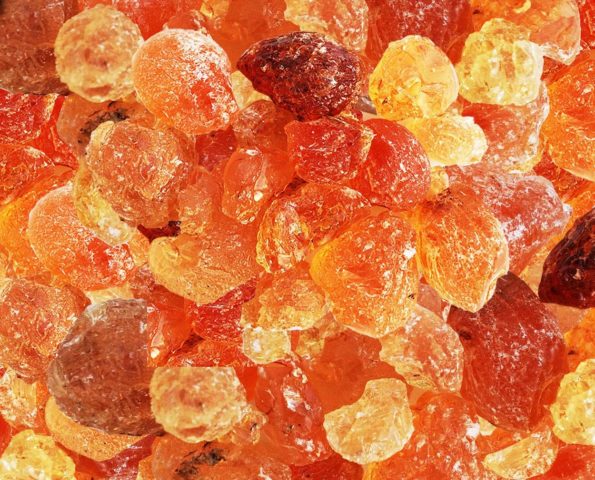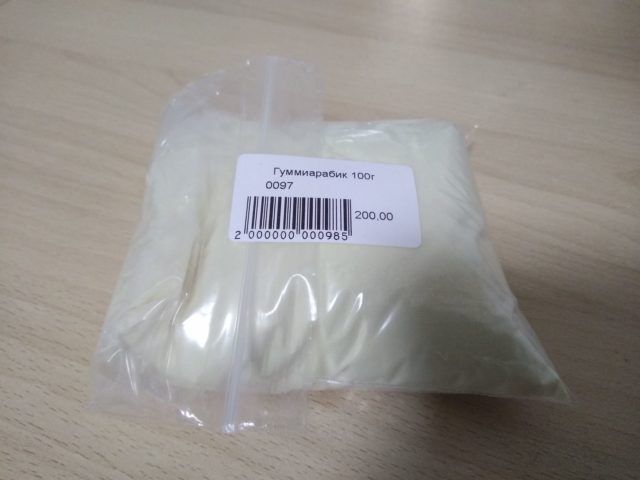Content
The stabilizer gum arabic belongs to the class of emulsifiers. He is responsible for the viscosity of products, their consistency and plasticity. The substance has been assigned a zero hazard class, so there is no point in refusing to use products that contain E414. The stabilizer is approved in the countries of the European Union, Russia, Ukraine, USA, Canada and other countries.
What is the additive E414
Gum arabic is a natural substance. It acts as a stabilizer, emulsifier, binding agent. In the international codification, the preservative is assigned the E414 index. The name gum arabic in translation means gum arabic (Gum Arabic).
The stabilizer is a weakly acidic or neutral polymer, which consists of fragments of polysaccharides and protein components - polypeptides. The substance contains a glycoprotein containing glucuronic acid, galactose, 6-deoxymanose, minerals and amino acids.
The additive looks like a solid, yellowish-white or amber mass. The stabilizer has no smell, the taste is neutral.
The properties of gum arabic, which are due to its composition, include:
- low hygroscopicity - the ability to absorb moisture from the air;
- increased rate of hydration - attachment of water molecules to the substance;
- the ability to fix color;
- good solubility in water.
The stabilizer is thermally stable. When gum arabic E414 is dissolved in cold water, a sticky solution with a slightly acidic reaction is obtained. This substance retains moisture well and redistributes fat particles in food.
Gum arabic is marketed in the form of powder, irregular granules or flakes.
What is the gum arabic thickener made of?
Stabilizer E414 is a natural substance. It is a natural resin that is extracted from certain types of acacia trees. Most often, Acacia Senegal and Vachellia Seyal are used for these purposes. They grow in a number of African countries, in India, Australia.
About 80% of exports go to Sudan. But the main world suppliers of gum arabic are also Nigeria, Chad, India. The resin is harvested from wild trees. France is the leader in the processing of this substance and the manufacture of food stabilizers.

In the hot season, cracks appear on the bark of acacia trees, from which juice flows. When dry, it forms solidified drops. Previously, they were harvested by hand, peeled from the remains of the bark and sorted by color. But now production technologies have changed. On an industrial scale, gum arabic is mined by special mechanical action.
The collected resin is crushed so that a white powder is obtained. If gum arabic is planned to be used for food production, then the resulting mass is additionally purified. For this, the substance is dissolved in water, subjected to a membrane filtration process under pressure and pasteurization. Spray drying is used to obtain the final product.
The benefits and harms of gum arabic
The stabilizer is well researched. In the process of research it was found that it is a harmless substance. There is no negative effect on the body when using the food additive E414.
Acacia gum is broken down in the large intestine. This process is accompanied by the release of polyunsaturated acids, which act as a source of energy and participate in the metabolic process. The benefits of gum arabic can hardly be overestimated. When ingested, the stabilizer binds and promotes the removal of radionuclides, mercury salts, and lead.
The food supplement is a source of highly soluble fiber. When it is included in the diet, 80% of the body's need for dietary fiber can be satisfied. The intake of gum with food contributes to:
- reduce the risk of developing type 2 diabetes;
- reducing the likelihood of diseases of the digestive tract;
- normalizing blood cholesterol levels;
- maintaining the immune system.
With the intake of dietary fiber in the body in sufficient quantities, the likelihood of developing obesity is greatly reduced. Acacia gum is recommended for people who want to get rid of toxins. The dosage of the stabilizer has not been determined, although some doctors advise to ensure that more than 2 g of this substance does not enter the body per 1 kg of human body weight.
Dangerous or not food additive E414
Gum arabic powder is allowed in all countries. It is an environmentally friendly and useful stabilizer. Doctors advise including it in the diet for people who consume insufficient amounts of fiber. According to official reports, the additive is non-toxic.
The supplement is not absorbed in the digestive tract. The fiber contained in it has a beneficial effect on the functioning of the digestive tract.

The use of gum arabic
The stabilizer E414 is used in the food industry, medicine, and cosmetology. It is used as:
- an emulsifier;
- texture improver;
- an anti-foam agent;
- freezing point regulator;
- a film-forming substance.
Gum arabic helps to increase the volume of finished products. Stabilizer E414 can be used simultaneously with other types of gums, they are well combined with each other.
The most actively used gum arabic in the manufacture of food. It promotes the formation of a uniform oil-water emulsion, has a stabilizing effect on liquids that do not mix with each other. These properties are used in the manufacture of drinks with the addition of essential oils (lemon, orange and others), chocolate milk, and extracted tea.
As a binder, it is used in solutions that are used to form a shell in the form of pills for such products:
- raisins;
- nuts;
- sweets and other similar products.
Gum arabic prevents the crystallization process, strengthens the bond between the inner and outer layers, fills the voids formed.
The emulsifier is used in the production of dairy products. It is added in the process of making cream, ice cream, yoghurts, creams. When using a stabilizer, it is possible to obtain a stable emulsion and increase the volume of the finished product.
E414 is added when baking confectionery and bakery products. Gum arabic is essential to prevent sugar, lumping and foam formation. At the same time, the taste of the product remains unchanged. This is important when making cookies, icing, and pastilles.
Gum arabic is used in winemaking. The specified substance is added to red wines as a color fixative. E414 binds metal ions. In dry wines, gum reduces acidity and improves taste.
In the manufacture of chewing gums and candies, gum arabic acts as an encapsulating material for flavoring additives. Under its action, the smell is released not immediately, but gradually. This leaves a pleasant aftertaste for a long period.
Uronic acid, which is part of gum arabic, interacts with proteins contained in beer. The addition of 0.025% stabilizer to the beer wort after the fermentation process is complete makes the foam dense and stable. And a 1% gum solution is used to clarify elite beers.
Gum arabic E414 is used in the manufacture of non-alcoholic and alcoholic carbonated drinks. It becomes a source of fiber in them.

The pharmaceutical industry uses a stabilizer in the manufacture of encapsulated vitamin preparations, coated tablets. It is included in the composition of medicines with an enveloping and analgesic effect, which are intended for the treatment of enterocolitis, dysentery, diseases of the digestive system, urinary system.
In cosmetology, gum arabic is used to create a pleasant-to-touch texture of creams, gels, and shampoos. As a "former" of the film coating, it is added to lipstick, mascara. Acacia gum moisturizes the skin and protects it from the harmful effects of ultraviolet rays. Under its influence, the process of collagen production is stimulated.
Conclusion
The stabilizer gum arabic is a harmless substance that is used in the manufacture of certain food products and medicines. It has no negative effect on the body. Regular use of acacia gum, which is a source of fiber, is recommended to prevent the development of a number of diseases.

